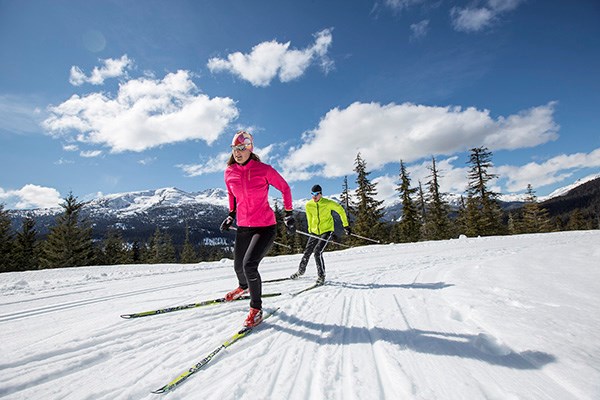There are two techniques in cross-country skiing – classic and skating. When thinking about classic, the archetypal, rustic Scandinavian Nordic skier comes to mind, effortlessly gliding through snow-covered forests. Skating, on the other hand, embodies more the fast and furious way of moving on skinny skis, as the technique is generally quicker and more dynamic than classic skiing. But did you know that it could actually be called the “American way” of skiing?
Classic technique, the alternating motion of legs and arms in diagonal stride with skis gliding parallel in set tracks, was traditionally the way to go cross-country skiing all over the world. However, in the ’70s, participants in long-distance races started using a technique called “marathon skate.” Leaving one ski in the track, they used the other one in an angled, ice-skate like motion outside the track. It helped long-distance racers to continue skiing even when the wax no longer worked and muscles were tired after many kilometres of skiing, and it also turned out to be faster than the classic, diagonal stride.
More and more marathon skiers used that technique – and one ingenious North American noticed that. U.S. World Cup cross-country skier Bill Koch had participated in a couple of traditional loppets in Scandinavia and was fascinated by the technique. After refining it in his daily training, Koch started using it in races – and won a World Championship bronze and the 1982 overall World Cup title using it.
After Koch’s big success, more and more competitive skiers adopted the innovative style. At first, race organizers and ski associations hesitated to accept the new technique and even tried to ban it from races. But athletes continued to use it, so in 1985, “freestyle” was introduced as a new racing category alongside “classic” for cross-country competitions. Skating also became the technique of choice for biathletes and Nordic combined athletes.
Over the years, more and more recreational skiers picked up the new technique, including new skiers who were fascinated by the dynamic and fast gliding motion. In Canada, the participation base for cross-country has grown remarkably thanks to skate skiing – in fact, it is especially easy to learn for most Canadians, many of whom grow up ice skating and playing hockey.
With all the excitement about skating, one should not forget about classic skiing, though, that form of majestic and sophisticated gliding that still beats skating in certain weather conditions, even in the Sea to Sky Corridor.
Spring break Nordic camps
If your child wants to do something fun and unique during spring break, consider one of Whistler Olympic Park’s multi-day sport camps. Three full-day camps will be offered, two of them featuring a mix of all Nordic sports including cross-country, biathlon and ski jumping, and one of them concentrating on ski jumping exclusively. Fun activities like snowshoeing, ski play and scavenger hunts are also on the schedule. Children and youth between 8 and 14 years of age can participate. Basic ski skills (downhill or Nordic) are required.
The ski jumping camp takes place from March 23 to 27 (9 a.m. to 3 p.m.), while the multi-sport camps are scheduled for March 23 to 27 (9 a.m. to 3 p.m.) and March 30-April 2 (9 a.m. to 3 p.m).




